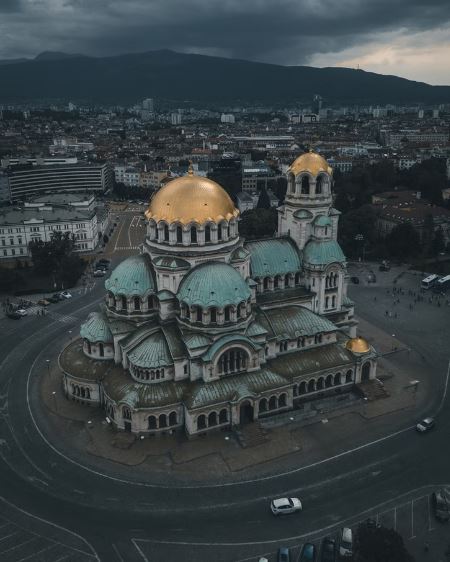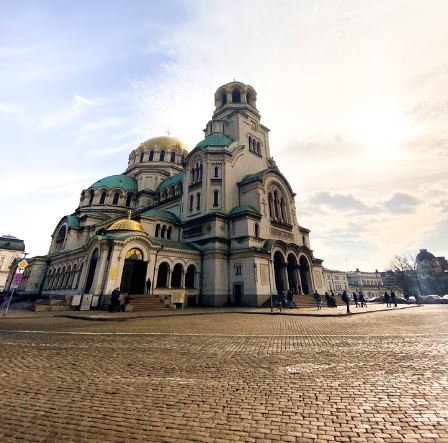Sofia is Bulgaria’s capital and largest city. In the western part of the country, it is located in the Sofia Valley at the foot of Vitosha Mountain. The city is situated west of the Iskar River and is home to several mineral springs, including the Sofia Central Mineral Baths. Also, do not miss the foods you must try when visiting Bulgaria. The climate is humid continental. It is located in the heart of the Balkans, halfway between the Black Sea and the Adriatic Sea, and the Aegean Sea.
Sofia, known in antiquity as Serdica and in the Middle Ages as Sredets, has been inhabited since at least 7000 BC. The city’s recorded history begins with the attestation of the Roman Republic’s conquest of Serdica from the Celtic tribe Serdi in 29 BC. Huns, Visigoths, Avars, and Slavs raided the city during the Roman Empire’s decline. Khan Krum incorporated Serdica into the Bulgarian Empire in 809, and it became known as Sredets. The Byzantines ended Bulgarian rule in 1018, but the reborn Bulgarian Empire reincorporated it in 1194. Sredets grew into a key administrative, economic, cultural, and literary center until the Ottomans conquered it in 1382. Sofia was the regional capital of Rumelia Eyalet, the Ottoman Empire’s key European province, from 1530 to 1836. In 1878, Bulgarian rule was restored. In the following year, Sofia was chosen as the capital of the Third Bulgarian State, ushering in a period of rapid demographic and economic growth.
Name of Sofia
The name Sofia comes from the Saint Sofia Church, as opposed to Bulgarian cities and towns having a predominantly Slavic origin. The name comes from the Greek word Sophia, which means wisdom. The perfect copy of the Gospel of Serdica, in a dialogue in both two salesmen from Dubrovnik around 1359, the 14th-century Vitosha Charter of Bulgarian tsar Ivan Shishman, and a Ragusan merchant’s notes from 1376 are the earliest works where this latest name is recorded. The city is referred to as Sofia in these documents, but the region and its inhabitants are still referred to as Sredecheski, as they were until the twentieth century. The name Sofya became popular among the Ottomans. The citizens of Bulgaria formed a committee of famous people in 1879 to decide on the name of the new Bulgarian capital, insisting on a Slavic name. Gradually, a compromise emerged, with Sofia becoming official for national institutions while Sredets became official for administrative and religious institutions before the latter was neglected over time.
Geography of Sofia
Sofia City Province covers 1344 square kilometers, while the larger Sofia Province covers 7,059 square kilometers. Sofia’s growth as an important resolution is largely due to its strategic location in the Balkans. It’s in western Bulgaria, at the northern foot of the Vitosha mountain, in the Sofia Valley, which is surrounded to the north by the Balkan mountains. The valley is 550 meters above sea level on average. Sofia is the European Union’s second-highest capital and Europe’s third-highest capital. Sofia, unlike most European capitals, does not sit on a large river and is surrounded by relatively high mountains. Vitosha is the watershed between the Black and Aegean Seas, and three mountain passes lead to the city, which has been an important road since antiquity.
The Boyanska, Vladayska, and Perlovska are three shallow rivers that run through the city. The upper course of the Iskar River flows near eastern Sofia. It rises in the Rila, Bulgaria’s highest mountain, and flows into Sofia Valley near the German village. The Iskar flows north toward the Balkan Mountains, passing through the eastern city suburbs, next to Sofia Airport’s main building and below the runways, and emerging from the Sofia Valley at Novi Iskar, where the scenic Iskar Gorge begins. There are 49 mineral and thermal springs in the city. The twentieth century saw the construction of artificial and dam lakes.
Climate of Sofia
With an average annual temperature of 10.9 degrees Celsius, Sofia has a humid continental climate. The winters are chilly and snowy. With sudden significant temperature amplitudes, weather can be very unstable and dynamic. So it is better to check the temperatures first to surely enjoy your trip to the sea of Bulgaria. Temperatures can drop below 15 °C on the coldest days, especially in January. 31.2 °C is the lowest temperature ever recorded. Fog is not uncommon, particularly early in the season. Sofia averages 96 cm of snowfall per year and 57 days with snow cover. 1995/1996 was the snowiest winter on record, with 171 cm of snowfall. 1893 was the coldest year on record, with an average January temperature of 10.4 degrees Celsius and an annual temperature of 8.2 degrees Celsius.
The summers are hot and humid. Due to its higher altitude, the city is slightly cooler in the summer than in other parts of Bulgaria. Heat waves do occur in the city, with high temperatures reaching or exceeding 35 °C on the hottest days, especially in July and August. The highest temperature ever recorded was 41 degrees Celsius. July 2012 was the hottest month on record, with an average temperature of 25 degrees Celsius. With an annual temperature of 11.9 °C, 2019 was the warmest year on record. Sofia’s spring and autumn seasons are usually brief, with unpredictable weather. The city receives an average of 625.7 mm of precipitation per year, with thunderstorms being common in late spring and early summer. The driest year on record was 2000 when total precipitation was 304.6 mm, and the wettest year was 2014 when total precipitation was 1,066.6 mm.
Environment of Sofia
The Sofia Valley’s geographical location restricts the flow of air masses, increasing the risk of particulate matter and nitrogen oxide pollution. Pollution comes from solid fuels used for heating and from motor vehicle traffic. As a result, smog persists over the city due to temperature inversions and the mountains surrounding the city preventing air mass circulation. As a result, Sofia has some of Europe’s worst air pollution levels.
Particulate matter levels are consistently higher than the national average. During the heating season from October 2017 to March 2018, particulate levels exceeded the EU norm on 70 occasions; on January 7, 2018, PM10 levels reached 632 g/m3, more than twelve times the EU norm of 50 g/m3. PM2.5 and PM10 levels were above safe thresholds even in areas with few sources of pollution, such as Gorna Banya. In January 2018, the Municipal Council implemented several measures in response to dangerous spikes in air pollution, including more frequent street washing. However, according to a report released by the European Court of Auditors in September 2018, Sofia has not developed any plans to reduce air pollution caused by heating. Despite the presence of industrial facilities in Sofia, no industrial pollution monitoring stations are operational, according to the report. A monitoring station on Eagles’ Bridge, which had measured some of the highest particulate matter levels, was moved away from the site and has since measured much lower levels. Since 2017, a network of 300 sensors maintained by volunteers has largely measured particulates. Bulgaria has been taken to court by the European Commission for failing to reduce air pollution.

